#Fujifilm GFX 100 Mirrorless Camera
Explore tagged Tumblr posts
Text
Fujifilm GFX 100S Mark II vs. Fujifilm GFX 100 Mark II: Medium Format Mirrorless Camera Comparison
Features
Fujifilm GFX 100S Mark II
Sensor: 102MP Medium Format CMOS sensor
Processor: X-Processor 4
Image Stabilization: 5-axis in-body stabilization (up to 6 stops)
Autofocus: 425-point phase detection AF
Video: 4K/30p video recording
Viewfinder: 3.69M-dot electronic viewfinder
LCD: 3.2-inch 2.36M-dot tilting touchscreen LCD
Build: Weather-sealed body
Weight: Approximately 900g
Battery: NP-W235 battery with improved battery life
Fujifilm GFX 100 Mark II
Sensor: 102MP Medium Format CMOS sensor
Processor: X-Processor 4
Image Stabilization: 5-axis in-body stabilization (up to 5.5 stops)
Autofocus: 425-point phase detection AF with improved performance
Video: 4K/30p video recording
Viewfinder: 5.76M-dot detachable electronic viewfinder
LCD: 3.2-inch 2.36M-dot tilting touchscreen LCD
Build: Magnesium alloy body with enhanced weather sealing
Weight: Approximately 1400g
Battery: Dual NP-T125 batteries for extended use
Differences
Size and Weight:
GFX 100S Mark II: Lighter and more compact at 900g, making it more portable.
GFX 100 Mark II: Heavier at 1400g, offering a more robust build.
Viewfinder:
GFX 100S Mark II: Fixed 3.69M-dot electronic viewfinder.
GFX 100 Mark II: Detachable 5.76M-dot electronic viewfinder, allowing for more flexibility.
Battery:
GFX 100S Mark II: Single NP-W235 battery.
GFX 100 Mark II: Dual NP-T125 batteries for longer shooting sessions.
Build and Durability:
GFX 100S Mark II: Weather-sealed body.
GFX 100 Mark II: Magnesium alloy body with enhanced weather sealing, providing better durability.
Conclusion
Both the Fujifilm GFX 100S Mark II and the Fujifilm GFX 100 Mark II are exceptional medium format mirrorless cameras, each with its strengths. The GFX 100S Mark II is ideal for photographers who prioritize portability and ease of use, while still offering top-tier image quality and performance. On the other hand, the GFX 100 Mark II is better suited for those who need a more robust, professional-grade camera with extended battery life and a superior viewfinder.
Recommendation: If you need a more portable and lightweight option, the GFX 100S Mark II is the way to go. For extended shoots and a more durable build, the GFX 100 Mark II would be the better choice.
Interested in renting one of these amazing cameras? Visit Scheimpflug - Camera Rentals to explore our rental options for the Fujifilm GFX 100S Mark II and Fujifilm GFX 100 Mark II.
1 note
·
View note
Link
This Fujifilm GFX 100S Black Friday deal helps you save on the compact but mighty medium format mirrorless camera that's perfect for landscapes and more.
0 notes
Text
For these hardy Pentaxians who've weathered the storm for a very long time with their trusty Pentax 645Z medium format digicam, there is perhaps some mild on the finish of the tunnel in the case of a long-awaited successor. Whereas Pentax cannot determine which lenses will probably be renewed, what we do know is that if a Pentax 645Z (opens in new tab)-beater will get constructed it will not be a mirrorless digicam.• Among the greatest medium format cameras (opens in new tab) aren't truly mirrorless! This slightly curious information would not comes from rumors, however truly comes straight from Pentax itself through an interview in Japanese Cameraman journal (by the use of a report (opens in new tab) by Pentax Rumors).Apparently Pentax is presently contemplating new sensors for the subsequent 645 digicam, however it doesn’t have something particular to say concerning the alternative at this stage – aside from suggesting that, if it exceeds the present 50MP sensor, it would put older 645 FA lenses into query, as a result of their capability to work with larger decision sensors.(Picture credit score: Future)By these feedback, it is apparent that Pentax has not reached the testing stage at the moment – or it's retaining its playing cards near the chest, as testing may need discovered points.The panel continued to say that, "The present 645Z is extraordinarily good worth– it will not be doable to come back out with one thing on the identical worth now." Which might be fairly an understatement, as I'm positive everyone knows costs have gone up loads. At present the Pentax 645Z with the 75mm f/2.8 package lens at B&H (opens in new tab) or Adorama (opens in new tab) is priced at $3,996.95 – that is an incredible $3,000 off! The offers proceed within the UK the place digicam shops comparable to Wex (opens in new tab) or Park Cameras have the 645Z + 55mm f/2.8 (opens in new tab) listed for simply £4,999 – which is £1,500 off.There is no such thing as a arguing that even immediately this 50MP digicam is greater than able to producing excellent pictures – and being the primary weather-sealed medium format digicam to market that championed taking the studio outdoor, the costs above are actually a superb deal. So what's Pentax going to do to up the ante?(Picture credit score: Future)Going mirrorless is the apparent possibility, though according to Pentax' ongoing technique this isn't going to occur."It could be unfair to the individuals who had gathered their current lenses," stated the panel. And, when it was instructed that an adapter would resolve this, "Sure, however there can be an expectation that they'd come out with an entire set of recent lenses, which might not be reasonable for a few years."So, is the Pentax 645Z a sitting duck? I do not assume so. There are lots of loyal Pentax homeowners who swear by the 645Z, and even the older 645D; the techniques have an enormous quantity of AF lenses, with the FA and FA* lineup, and likewise the older guide focus lenses from the 120 movie (opens in new tab)days. So there may be nonetheless loads of life left within the system.(Picture credit score: Pentax)However we won't additionally ignore that point strikes on – now extra rapidly than ever – as evidenced by the likes of the Fujifilm GFX 50S II (opens in new tab) or Fujifilm GFX 100S (opens in new tab) with their wonderful trendy mirrorless specs, wonderful picture high quality, and a pretty price ticket to match.Will Pentax be capable to compete with a non-mirrorless digicam, in a now mirrorless market? It'll all come all the way down to prices, however there are many medium format backs on the market which have as much as 80 and 100 megapixels which are able to getting used with mirror-mechanical cameras. So it is definitely not over till it is over…Immediately's greatest Pentax 645Z offersIf this text has been of curiosity to you, why not check out our Pentax 645Z evaluate (opens in new tab) or take a look at our listing of the highest-megapixel cameras on the earth (opens in new tab).
#Pentax #talks #645Z #medium #format #successor #wont #mirrorless
0 notes
Text
Best Mirrorless Camera In 2021 | Leeds | UK
Best Mirrorless Camera In 2021 | Leeds | UK
1. Sony A7S Mark III Body (Black) The Sony Alpha a7S III raises the bar for what a full-frame mirrorless camera is capable of. A revised 12.1MP Exmor R BSI CMOS sensor and updated BIONZ XR image processor offer faster performance, improved noise reduction, and a wider dynamic range, along with UHD 4K 120p video recording and internal 10-bit 4:2:2 sampling. The a7S III also does away with…

View On WordPress
#Best Mirrorless Camera#Best Mirrorless Camera In 2021#Best Mirrorless Camera In 2021 | Leeds#Best Mirrorless Camera In 2021 | Leeds | UK#Camera#Fujifilm GFX 100 Mirrorless Camera#Justclik#Leeds#Mirrorless Camera#Nikon Z7#Panasonic Lumix DC-S1H Body#Sony A7S Mark III Body#UK
0 notes
Link
#Best Mirrorless Camera for Professionals#Best Mirrorless Camera#Best Camera for Professional Photography#Best Digital Camera#Mirrorless Camera#Fujifilm GFX 100S#Fujifilm Camera India#Fuji Camera#Fujifilm Camera#Fujifilm X-E4#Fujifilm X-S10#Fujifilm#Fujifilm X-T4#FujifilmXseries
2 notes
·
View notes
Text
Gordon Laing: 100MP for $6k! Fujifilm GFX 100S review
Gordon Laing: 100MP for $6k! Fujifilm GFX 100S review
“The Fujifilm GFX 100S is a medium format mirrorless camera with 100 Megapixels, built-in stabilisation and 4k video. Announced in January 2021, it’s the fourth model in Fujifilm’s GFX series, inheriting the sensor from the flagship GFX 100 but presenting it in a more compact and much more affordable body….” Fujifilm GFX 100S with Fujinon GF 110mm f/2.0 R LM WR prime lens. Image courtesy of…
youtube
View On WordPress
#Fujifilm digital hybrid cameras#Fujifilm GFX 100S#medium format cameras#medium format mirrorless cameras#medium format sensors#Youtube
1 note
·
View note
Text
Fujifilm GFX 100S mirrorless camera launched in India!
Fujifilm GFX 100S mirrorless camera launched in India!
GFX100S is the first mirrorless digital camera featuring the world’s highest*1 102MP large-format sensor. Launched through a virtual event, the company also announced the X-E4 mirrorless digital camera along with three new lenses. Fujifilm India Private Limited, a pioneer in imaging technologies, announced the expansion of its cutting-edge mirrorless cameras by introducing the imaging…

View On WordPress
1 note
·
View note
Text
HND1 Photography Report Task: Capture & Output
DIGITAL CAMERA SENSORS A digital camera uses an array of millions of tiny light cavities or "photosites" to record an image. When you press your camera's shutter button and the exposure begins, each of these is uncovered to collect photons and store those as an electrical signal. Once the exposure finishes, the camera closes each of these photosites, and then tries to assess how many photons fell into each cavity by measuring the strength of the electrical signal. The signals are then quantified as digital values, with a precision that is determined by the bit depth. The resulting precision may then be reduced again depending on which file format is being recorded (0 - 255 for an 8-bit JPEG file).
Digital Camera Sensor Types Medium Format Medium format is the largest sensor type in digital cameras for photographic applications. However, it doesn’t come in just one size. Medium format has its own group of sensors, with its own equivalents to the four thirds, APS-C, and full-frame formats. There are a variety of sensor sizes for medium-format cameras, and typical sizes range from around 43.8×32.9mm to 53.7×40.2mm.
Due to their large image sensors, medium-format DSLR cameras are traditionally heavier and bulkier than their full-frame counterparts. But that changed, as brands like Hasselblad have come out with smaller mirrorless medium-format cameras like the X1D II to provide photographers with a lighter, more compact option. The newer Fujifilm GFX 100 is also a medium-format mirrorless camera and holds a whopping 102MP resolution.
35mm Full-Frame Full-frame sensors are available in both DSLR and mirrorless cameras. They have the same dimensions as the 35mm film, hence the name. The 35mm full-frame sensor type is the gold standard among professional photographers who want the highest-quality images.
The dimensions of a 35mm sensor are typically 36×24mm.
The Canon EOS R5, for example, is a full-frame mirrorless camera option, and the popular Nikon D850 DSLR has a FX full-frame sensor.
APS-H The groundbreaking EOS-1D was the first Canon camera to carry the APS-H sensor type was, and it launched in 2001. Canon released four more cameras (all members of the 1D line) with the same sensor type before discontinuing it.
The APS-H is slightly larger than the APS-C sensor format that many Canon DSLR cameras use today but smaller than a traditional full-frame sensor.
APS-C The APS-C or crop-sensor format is the most well-known and most versatile of the bunch. The APS-C sensor is popular in DSLR and mirrorless cameras alike. Beginners and professionals alike use it thanks to its adaotability.
The typical APS-C sensor size is different across camera brands. Canon APS-C sensors are usually 22.3×14.9mm, while other brands like Nikon, Sony, Pentax, and more usually feature APS-C sensors with 23.6×15.6mm dimensions. Many cameras including the Canon EOS M50 Mark II, Fujifilm X100V, Sony Alpha a6600, and Nikon Z50 all hold APS-C sensors
Four Thirds/Micro Four Thirds Created by Olympus and Panasonic, the Four Thirds System is a standard that allows for the compatibility of lenses and bodies across participating camera makers. Image sensor size is 17.3×13mm with a crop factor of 2.0 when compared to full-frame camera sensors.
On the mirrorless camera side, we have the Micro Thirds Format System, first released in 2008. It shares the Four Thirds System’s sensor size and specifications but uses a compact design with no space for the movable mirror, pentaprism, and other parts of the DSLR mechanisms not found in mirrorless cameras.
The Four Thirds System uses a 4:3 image aspect ratio, hence the name, and is featured in cameras like the Blackmagic Design Pocket Cinema Camera 4K. The Micro Four Thirds System uses the same ratio but can also record 16:9, 3:2, and 1:1 formats, and is included in cameras like the Olympus OM-D E-M1 Mark III and Panasonic Lumix G9.
1” Type (and below) Any sensor that is about 1.5 to 1-inch in size or smaller can be found in non-interchangeable lens cameras (your typical point and shoot) and smartphone cameras.
High-end compact cameras like the Panasonic Lumix DMC-LX10 and the Sony Cyber-Shot DSC-RX10 IV use 1-inch sensors, allowing these cameras to produce good results—in terms of image and video quality—that you won’t get with regular point-and-shoot cameras.
Dynamic Range
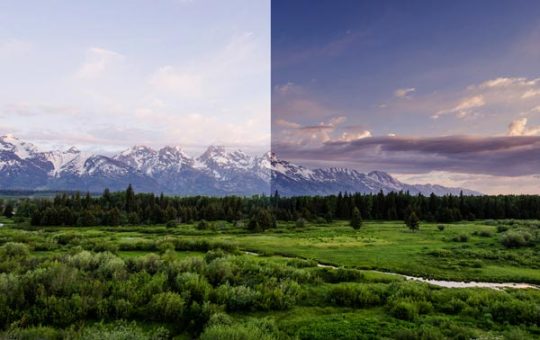
If you’ve ever had to take a photograph on a bright sunny day, chances are pretty high that you would have lost detail, possibly in the shadows or in the highlights, perhaps even both. This is not an exposure problem on your part, it’s more likely a limitation of the dynamic range of your camera – almost all cameras will come up against this problem at some time.
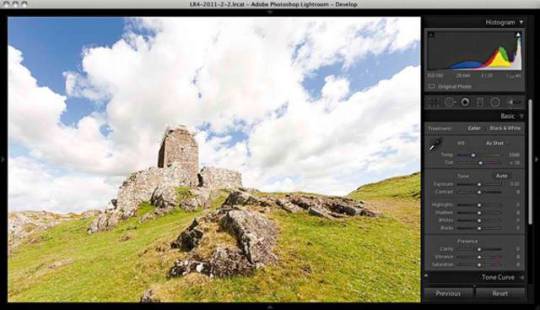
Notice the sky is lacking in detail. It is over exposed – outside of the range of the camera. There are actually two dynamic ranges you need to think about. One is the dynamic range of the subject, the second is the dynamic range of your camera. The dynamic range of the subject is a measure of the range of light intensities from the shadows to the highlights. In low light conditions the dynamic range (that is the difference between the darkest and the latest part of the subject) is quite small. On a bright sunny day that range is much higher and is often outside the range of the camera. Different cameras and different sensors will have bigger or smaller dynamic ranges. As long as the dynamic range of the subject doesn’t exceed the dynamic range of your camera you will be able to get a perfectly exposed photograph.
If the subject dynamic range is bigger than the cameras dynamic range and one part of your subject will be either under or over exposed. You can easily tell if the subject’s dynamic range exceeds that of your camera by using the histogram on your rear screen.
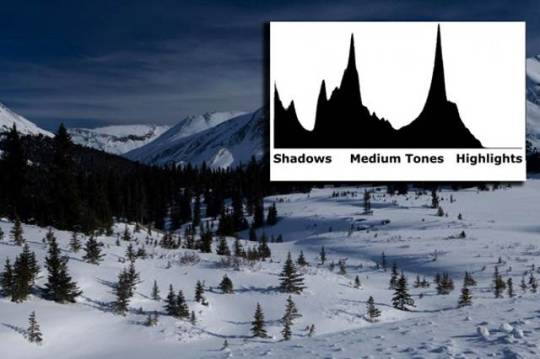
The histogram shows the range of subject brightness starting with black on the left going to white on the right. The width of the histogram chart represents the dynamic range of your camera sensor.
If the histogram fits inside of the histogram display area then the dynamic range of the subject is inside that of your camera and everything is good. If the histogram is clipped at either end then the subject range is too wide. Try changing your camera exposure and watch the histogram move left or right and see if you can fit the histogram inside of the display.
On the histogram shown you can see you can see the shadow area is outside of the sensor’s ability to register. The signal is “clipped” with no details being recorded. The left side of the histogram is crammed up tight against the edge, showing lack of detail.
On the right of the histogram there is still room – the photographer could open up the iris (or use a slower shutter speed) and get more detail in the shadow area without sacrificing detail in the highlights.
Be careful not to over expose the highlights!
A blown out highlight looks terrible whereas a shadow lacking detail is acceptable.
If the subject’s dynamic range is too big and will not fit in histogram and then you need to choose where you will lose information. Ninety-nine percent of the time a photograph that is exposed so the highlights have full detail and the shadows just go black with no detail is a much better option and gives a much more pleasing photograph than one where there is full detail in the shadow but where the highlights are completely burned out.
The almost golden rule is “expose for the highlights,” that is, expose so the highlights are not clipped. Shadows by definition are dark and it is hard to see detail there, so, if you have to loose a portion of the dynamic range it is almost always preferable to loose in the shadows.
There are ways to lift shadows – consider using a fill in flash or a reflector to lighten up those areas if they are close enough to the flashgun that it would have an effect.
Another option – and always a good piece of equipment to have in your camera kit – is to use a graduated neutral density (ND) filter.
BIT DEPTH
Bit depth is one of the most fundamental and important parameters you're likely to come across in photography and videography. This great video will give you a quick introduction to what bit depth is and why it matters to your work.
Coming to you from ZY Productions, this quick and informative video will teach you about bit depth. Bit depth is essentially how much information your camera can store in each color channel for each pixel. For example, a camera with 8-bit color depth can store a string of eight 0s and 1s in each color channel for each pixel. Since there are two possibilities (0 or 1) in each slot and eight slots overall per channel, that equates to 2^8=256 values per channel. Since there are three overall channels, this equates to (2^8)^3=16,777,216 total colors. Altogether, higher bit depths are better, as they create finer gradations, and this results in smoother transitions between tones. As the video notes, the standard JPEG is 8-bit, whereas raw files are typically 12-bit or 14-bit files. This is by far one of the best reasons to shoot in raw; the massive gain in information you get from those extra bits creates much more post-processing latitude. Check out the video above for more.
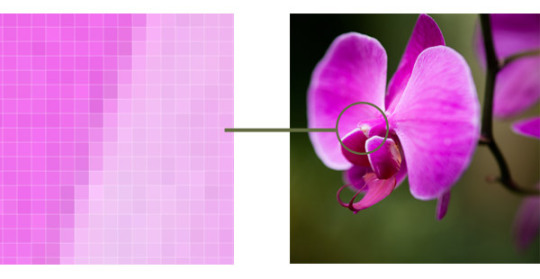
there is some lin with video about bit depth:
https://youtu.be/Z-0hszXbYD0
DIGITAL NOISE
Digital camera image noise
"Image noise" is the digital equivalent of film grain for analogue cameras. Alternatively, one can think of it as analogous to the subtle background hiss you may hear from your audio system at full volume. For digital images, this noise appears as random speckles on an otherwise smooth surface and can significantly degrade image quality. Although noise often detracts from an image, it is sometimes desirable since it can add an old-fashioned, grainy look which is reminiscent of early film. Some noise can also increase the apparent sharpness of an image. Noise increases with the sensitivity setting in the camera, length of the exposure, temperature, and even varies amongst different camera models.
CONCEPT: SIGNAL TO NOISE RATIO
Some degree of noise is always present in any electronic device that transmits or receives a "signal." For televisions this signal is the broadcast data transmitted over cable or received at the antenna; for digital cameras, the signal is the light which hits the camera sensor. Even though noise is unavoidable, it can become so small relative to the signal that it appears to be nonexistent. The signal to noise ratio (SNR) is a useful and universal way of comparing the relative amounts of signal and noise for any electronic system; high ratios will have very little visible noise whereas the opposite is true for low ratios. The sequence of images below show a camera producing a very noisy picture of the word "signal" against a smooth background. The resulting image is shown along with an enlarged 3-D representation depicting the signal above the background noise.
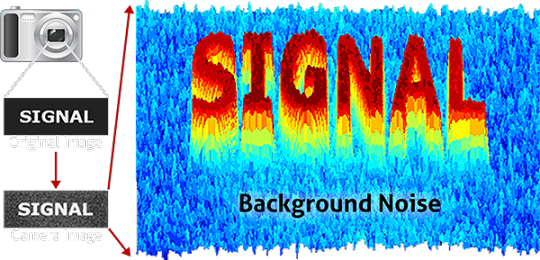
The image above has a sufficiently high SNR to clearly separate the image information from background noise. A low SNR would produce an image where the "signal" and noise are more comparable and thus harder to discern from one another.

ERMINOLOGY: ISO SPEED
A camera's "ISO setting" or "ISO speed" is a standard which describes its absolute sensitivity to light. ISO settings are usually listed as factors of 2, such as ISO 50, ISO 100 and ISO 200 and can have a wide range of values. Higher numbers represent greater sensitivity and the ratio of two ISO numbers represents their relative sensitivity, meaning a photo at ISO 200 will take half as long to reach the same level of exposure as one taken at ISO 100 (all other settings being equal). ISO speed is analogous to ASA speed for different films, however a single digital camera can capture images at several different ISO speeds. This is accomplished by amplifying the image signal in the camera, however this also amplifies noise and so higher ISO speeds will produce progressively more noise.
TYPES OF NOISE
Digital cameras produce three common types of noise: random noise, "fixed pattern" noise, and banding noise. The three qualitative examples below show pronounced and isolating cases for each type of noise against an ordinarily smooth grey background.
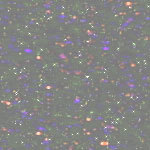
Fixed Pattern Noise Long Exposure Low ISO Speed
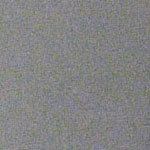
Random Noise Short Exposure High ISO Speed

Banding Noise Susceptible Camera Brightened Shadows
2 notes
·
View notes
Photo
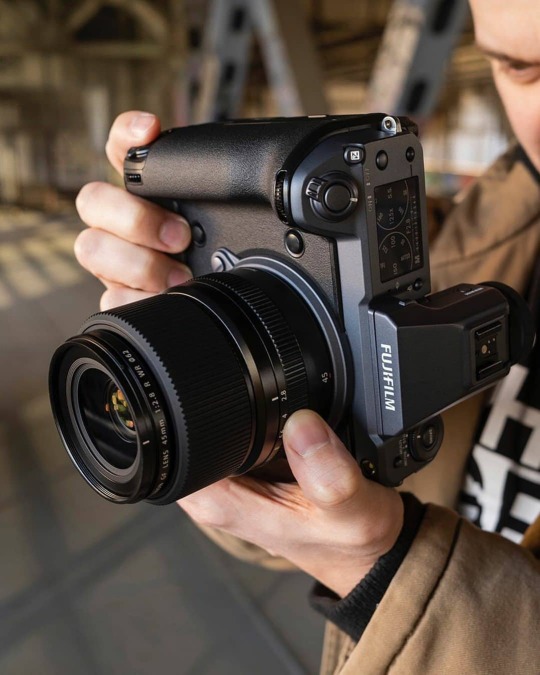
Mirrorless medium format camera with in-body image stabilization 💪 ⠀ Fujifilm 𝗚𝗙𝗫100 ⠀ #fujifilm #fujigfx100 #fujifilmxseries #fujifilmgfx #fujifilmgfx100 #gfx100 #fujifilmgfx50s #fujigfx50s #fujifilmgfx50r #gfx50r #gfx50s #gfx #fujifilmphotography #fujifilmcamera #cameraporn #mediumformat #fujinon #mediumformatcamera #mirrorlesscamera #fujifilmx #fujifilmmirrorless #photogear #ThePhotoGear https://www.instagram.com/p/B-QAU7rgk7b/?igshid=1lxtmrfs64uth
#fujifilm#fujigfx100#fujifilmxseries#fujifilmgfx#fujifilmgfx100#gfx100#fujifilmgfx50s#fujigfx50s#fujifilmgfx50r#gfx50r#gfx50s#gfx#fujifilmphotography#fujifilmcamera#cameraporn#mediumformat#fujinon#mediumformatcamera#mirrorlesscamera#fujifilmx#fujifilmmirrorless#photogear#thephotogear
1 note
·
View note
Text
Meet the all-new 100 Megapixel Fujifilm GFX 100 Mirrorless Camera
Fujifilm is a leading camera maker in the world with a huge number of advanced digital cameras for all types of users. The company has just introduced a new 100 Megapixel Mirrorless Camera. Yes, the new Fujifilm GFX 100 got introduced with 100 Megapixel. from TechnoCodex http://bit.ly/2YJuKbu
1 note
·
View note
Text

FUJIFILM GFX 100 Medium Format Mirrorless Camera
100MP sensor in a single-grip DSLR styled body.
Buy on Amazon
0 notes
Text
A 1,000 photo review with Hasselblad’s new X2D 100C
A 1,000 photo review with Hasselblad’s new X2D 100C
Hasselblad’s new $8,199 X2D 100C is utterly Hasselblad: an incredibly well built digital medium format camera that takes stunning photos pretty damn slowly. It’s not a workhorse; it’s a luxury cruiser. And in the mirrorless camera megapixel race, the X2D 100C’s 100 of them are only beaten by the 102 megapixels of Fujifilm’s GFX 100 and 100S. Good Stuff Feels incredible in your hands Highly…

View On WordPress
1 note
·
View note
Text
1,000 photos with Hasselblad’s new 100-megapixel camera
1,000 photos with Hasselblad’s new 100-megapixel camera
More pixels, more problems with the X2D 100C Hasselblad’s new $8,199 X2D 100C is utterly Hasselblad: an incredibly well built digital medium format camera that takes stunning photos pretty damn slowly. It’s not a workhorse; it’s a luxury cruiser. And in the mirrorless camera megapixel race, the X2D 100C’s 100 of them are only beaten by the 102 megapixels of Fujifilm’s GFX 100 and 100S. How we…

View On WordPress
0 notes
Link
#Fujifilm Camera#Fujifilm X-S10#Fujifilm X-T30#Fuji Camera#Fujifilm X-H1#Fujifilm X-T3#Fujifilm Camera India#Fujifilm GFX 100S#Fujifilm GFX 100S Price#Mirrorless Camera#Best Digital Camera#Best Camera for Professional Photography#Best Mirrorless Camera#Best Mirrorless Camera for Professionals
1 note
·
View note
Text
Full-Frame vs Crop Sensor | Which One Is the Best?

Have you ever wondered which is better; full-frame or crop sensor cameras? Full-frame vs crop sensor is a common debate. There’s quite a bit of (mis)information out there; full-frame being ‘better’, for one. Having used nearly every system (full-frame and crop) out there, I’ve come to realize that both have plenty to offer. So if full-frame vs crop is a question affecting your first camera purchase, let’s have a look at the advantages and disadvantages of each sensor size.
What Is a Camera Sensor?

Full-frame vs crop sensor? Which one is better? Photo by Qamera from Pixabay. A camera’s sensor is the digital equivalent of film. It consists of millions of photosites which register and record incoming light. This is where the megapixel (MP) count of your camera comes from. A 24 MP sensor has 24,000,000 individual photosites or pixels; the more photosites available, the higher the resolution of the photograph. If your camera is mirrorless, the sensor also acts as the autofocus unit that feeds the electronic viewfinder (EVF). This is one reason why the battery life of mirrorless cameras is low compared to DSLRs. With no separate phase-detection system or optical viewfinder (plus a smaller, mirrorless body), the sensor has to do a lot more work.

If you remove the lens from an interchangeable lens camera, you can see the rectangular shaped sensor inside. For DSLR cameras, you will need to flip the mirror in order to see it. Photo by Muhammad Ribkhan from Pixabay. Sensors come in several sizes: - 7.01 x 5.79mm sensor: The iPhone X has a sensor of this size. While tiny compared to interchangeable lens cameras, this is actually respectable for a smartphone camera; - 1-inch sensor: The Nikon J1 and Sony RX-100 line have a sensor size of 13.20 x 8.80mm;

The Nikon J1 camera has a 1-inch sensor. - Micro 4/3rds sensor: This is actually 17.30 x 13.00mm; - APS-C sensor: This is usually 23.60 x 15.70mm (depending on brand); and - Full-frame sensor: This is usually 35.00 x 24.00mm (depending on brand). But sensor sizes don’t stop there. Medium format cameras, such as the Fujifilm GFX line, have 44.00 x 33.00mm sensors. However, in this article, we’ll be focusing on the differences between full-frame and crop interchangeable lens formats, like APS-C and Micro 4/3rds.
The Meaning of Full-Frame and Crop
Why do we use the terms full-frame vs crop? Well, full-frame harks back to the days of film. Specifically, 35mm film photography, which–funnily enough–is also a crop format. It is crop because above that you have medium and large format cameras. When digital sensors came out, the term full-frame helped distinguish the sensors from APS-C, which are considered a crop format. Full-frame sensors were not the largest digital sensors at the time; the term helped film photographers transitioning to digital understand that equivalency in field of view and depth of field wouldn’t be a factor with a full-frame sensor.

A full-frame Canon camera body. Image by Pexels from Pixabay.
Advantages of Full-Frame
There are a number of advantages to full-frame sensors, including: - More Megapixels; - A better dynamic range; - Better light detection; - Low light performance; and - Beautiful bokeh. So let’s take a look at the key advantages of full-frame sensors in the full-frame vs crop debate. Do More Megapixels Matter? Higher resolution does not necessarily lead to better quality photos. How many megapixels you need is entirely dependent on you. In fact, there are even disadvantages to a higher resolution sensor. When it comes to full-frame vs crop, full-frame cameras tend to have the highest resolutions, like the upcoming Sony A7IV (61 MP). More resolution gives you more room to crop a shot without visibly losing image quality. This is useful if you view images on large, high-resolution screens. High-resolution images also mean more detail if you want to produce large prints.

Full-frame, high-resolution sensors are great if you want to produce large prints. Photo by JuergenPM from Pixabay. But if you’re sharing most of your images on social media only, a high-resolution camera will not be necessary. A 12 MP resolution would be more than enough to view on a screen, plus significantly fewer pixels are needed for smartphone viewing. You don’t look at a photo in a magazine from nose distance. So why would you blow up computer files to check for grain and noise if you aren’t making gallery prints? You need fewer megapixels than you think you do. High-resolution photos also have massive file sizes, that suck up processing power and hard drive space. Better Dynamic Range

Photo by Landon Nguyen. The current standard for both full-frame and crop is 24 MP, which also has a secondary benefit: improved dynamic range. Dynamic range refers to the range of light and dark tones the camera sensor is capable of rendering. The more refined the gradation, the higher the dynamic range the camera has. Dynamic range is less about the size of the sensor and more about the photosite quality (in terms of sensitivity and size). Full-frame sensors do usually have better dynamic range than crop cameras. This is because a 24 MP full-frame sensor has larger individual photosites compared to a 24 MP crop sensor. Better Light Detection Another benefit of a full-frame sensor is that the larger photosites are also more efficient at detecting light. Not only does the total light gathering area of the sensor increase with sensor size, but so do the individual pixels; making full-frame the best choice if you intend to shoot regularly in low light.

Full-frame has its advantages if you shoot high dynamic range scenes. Photo by David Mark from Pixabay. This means you’ll see a slight reduction in dynamic range and low-light noise performance if you’re using a high-resolution, full-frame sensor, but not as much as you might think. Technology like back-illuminated sensor (BSI), found in many full-frame (and a few crop sensor) cameras, helps negate the disadvantage of crowding pixels onto the sensor. Does Full-Frame Equal Better Low Light Performance?

Full-frame cameras tend to produce better images in low-light. Photo by mostafa meraji on Unsplash. This is a common question with a complex answer: yes and no. The larger sensor does mean a larger light gathering area, which can translate into better exposure and autofocus performance. But pixel size also plays a role in low-light performance, as does aperture, which is dependent on your lens, not your camera. Shutter speed selection, lens vibration reduction, sensor stabilization systems (which tend to be more efficient on smaller sensors), and tripods also help narrow the gap, depending on what you’re shooting. As a rule, though, you will get a cleaner image using a lower ISO with a full-frame camera. Full-Frame Equals Beautiful Bokeh Larger sensors also create a shallower depth of field for a given aperture and focal length. For example, if you’re using a 35mm f1.4 lens on a full-frame body like the Nikon D800, you’ll get a depth of field of approximately 0.16m from a subject distance of 1.5m. If you use that same 35mm f1.4 lens on an APS-C body, like the Fujifilm X-Pro 2, you’ll get the full-frame lens equivalent of a 50mm f2 in terms of depth of field and field of view.

Full-frame sensors create a shallower depth of field for a given aperture. Photo by Pexels from Pixabay. In short: a smaller sensor means you have to use faster lenses (wider apertures) to get the same shallow depth of field. As a very rough rule of thumb, you move back a stop of aperture in terms of the depth of field appearance per step from full-frame (APS-C, Micro 4/3rds, 1-inch). If you’re a portrait photographer who wants the best bokeh for his buck, the best option for you would be a full-frame sensor. Full-Frame Cameras Look Professional And lastly, there’s the marketing hype surrounding the term ‘full-frame’. Crop seems to suggest ‘inferior’ to full sensor size; despite the fact that that full-frame is actually a crop format. Read the full article
1 note
·
View note
Photo

RENTAL ONLY - FUJIFILM GFX 100S Medium Format Mirrorless Camera Body

RENTAL ONLY - FUJIFILM GFX 100S Medium Format Mirrorless Camera Body
GFX100S is a new generation of large format digital camera, designed to suit a new generation of creators. The 102MP back-illuminated CMOS sensor combines with the X-Processor 4 quad-core CPU to deliver images of ast..
https://ift.tt/3FegMUh November 11, 2021 at 08:05AM
0 notes